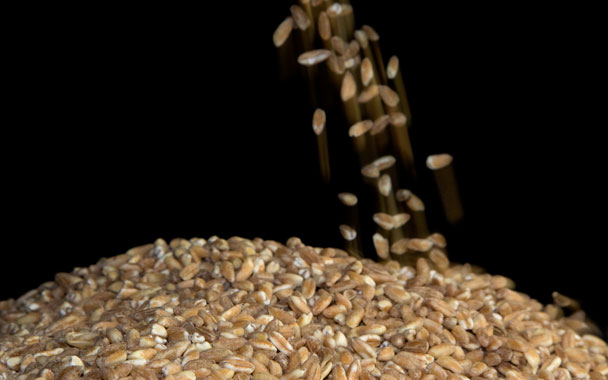Saturday mornings at the Union Square Greenmarket are a whole lot less crowded this time of year than in, say, June or September. The shoppers have a desperate air about them, hoping against hope that someone, anyone, will have something for sale besides parsnips, potatoes, and apples. One way out of the trap is to spend more time cooking grains, and if you haven’t cooked farro this year, now’s a great time to do it.
Farro is a cultivar of wheat—one of the very first varieties to be domesticated, it’s thought. Farro is popular in Tuscany, particularly in soups with beans, to which it adds both a nutty taste and a firm resistance to the tooth. Boiled and drained, salted generously and tossed with an aromatic oil or finely diced shallots and herbs, farro is a great foil for roasted poultry, meats, or squid, or a good addition to a beet and blue cheese salad. You’ll find farro in markets that sell Italian food. (Wheat berries make a perfectly fine substitute, too, and they’re available locally in most parts of the U.S.)
New to my repertoire this year is farrotto, which is farro cooked in the style of risotto. Risotto, of course, is a marriage between particular varieties of medium-grain rice (Arborio, Carnaroli, or Vialone Nano) and that labor-intensive moisten-stir-repeat technique, which rubs some of the starch off the rice and into the broth to make a viscous, soupy sauce for the remaining rice. Farro doesn’t break down in the same way, so the texture is a little different, but farrotto is rich, earthy, and robust.
My favorite farrotto idea so far came from a whole-grain cookbook by Lorna Sass. Soften a diced onion and a quarter-pound of pancetta or prosciutto in olive oil, then add the farro and toast it in the pot for a few minutes. Splash in some white wine, let it evaporate, then add a couple of cups of raw, grated winter squash and a generous amount of fresh or dried sage. Now pretend you’re making risotto—add 1/4 to 1/2 cup of simmering chicken stock, stir frequently as the pot bubbles and the farro absorbs the liquid, then repeat with another ladleful of stock until you’ve added a quart or so all told. The farro should be cooked but still chewy. Take the pot off the heat and stir in some grated Parmesan cheese and a handful of chopped toasted walnuts. March won’t seem so bad after all.




 Pinterest
Pinterest


